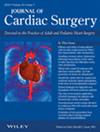Letter to the Editor: Gastrointestinal complications after cardiac surgery: Incidence, predictors, and impact on outcomes.
IF 1.3
4区 医学
Q3 CARDIAC & CARDIOVASCULAR SYSTEMS
引用次数: 0
Abstract
To the Editor, The article “Gastrointestinal complications after cardiac surgery: Incidence, predictors, and impact on outcomes” by Nicholas et al. has been read with great interest. It has been a privilege to read such a sophisticated literary work. We wholeheartedly concur with the study's findings regarding the rarity of gastrointestinal complications following cardiac surgery and their impact on early and late survival. The study briefly overviews the incidence and predictive risk factors for GI complications following cardiac surgery. However, we would be privileged to provide additional enhancements to its findings. First, the results were categorized based on sampling from a single institution and can raise various concerns. As one study conducted nationwide, had a higher ratio than study conducted in a single location. Additionally, multiple studies produced contradictory results. In one study, postoperative ileus was the most prevalent complication, whereas in another, Clostridium Difficile infection was the most pervasive complication. Numerous studies establish that leading cause of GI complications is splanchnic hypoperfusion resulting from low cardiac output and hypotension. The author should have mentioned the pathophysiology that leads to all GI complications proving a significant risk factor. Second, the study could have yielded more credible findings by highlighting which specific cardiac procedures posed greatest threat to the gastrointestinal tract. One study's findings, for instance, indicate that aortic aneurysm surgery carries the highest risk of gastrointestinal complications. Notably, the authors should have mentioned the risk factors for GI complications. As one article describes, three types of risk factors—preoperative, intraoperative, and postoperative—significantly impact the outcome and results. The author could have provided more insight into the surgical procedure by comparing on‐pump and off‐pump CABG. Study shows, there was a significant difference in GI complication trends and types. This could be decisive in procedure selection. Last, research is necessary for discovering ways to reduce mortality and prevent complications. In mesenteric ischemia and survival after laparotomy, for instance, off‐pump CABG patients demonstrated significant improvement in comparison to those using on‐pump technique. Recognition of gastrointestinal problems following cardiac surgery can be challenging. Any patient experiencing abdominal pain or tenderness should raise suspicions of a gastrointestinal side effect. Several authors have emphasized the significance of early recognition of gastrointestinal complications and a low cutoff point for laparoscopic exploration. Heart surgery will improve the cardiac status of many, allowing them to withstand general anesthesia and abdominal surgery. Pancreatitis is an additional potential complication. Rather than pancreatic cellular damage, a decreased rate of excretion into urine has been speculated as a significant cause of diabetes.致编辑的信:心脏手术后胃肠道并发症:发生率、预测因素和对结果的影响。
本文章由计算机程序翻译,如有差异,请以英文原文为准。
求助全文
约1分钟内获得全文
求助全文
来源期刊
CiteScore
2.90
自引率
12.50%
发文量
976
审稿时长
3-8 weeks
期刊介绍:
Journal of Cardiac Surgery (JCS) is a peer-reviewed journal devoted to contemporary surgical treatment of cardiac disease. Renown for its detailed "how to" methods, JCS''s well-illustrated, concise technical articles, critical reviews and commentaries are highly valued by dedicated readers worldwide.
With Editor-in-Chief Harold Lazar, MD and an internationally prominent editorial board, JCS continues its 20-year history as an important professional resource. Editorial coverage includes biologic support, mechanical cardiac assist and/or replacement and surgical techniques, and features current material on topics such as OPCAB surgery, stented and stentless valves, endovascular stent placement, atrial fibrillation, transplantation, percutaneous valve repair/replacement, left ventricular restoration surgery, immunobiology, and bridges to transplant and recovery.
In addition, special sections (Images in Cardiac Surgery, Cardiac Regeneration) and historical reviews stimulate reader interest. The journal also routinely publishes proceedings of important international symposia in a timely manner.

 求助内容:
求助内容: 应助结果提醒方式:
应助结果提醒方式:


